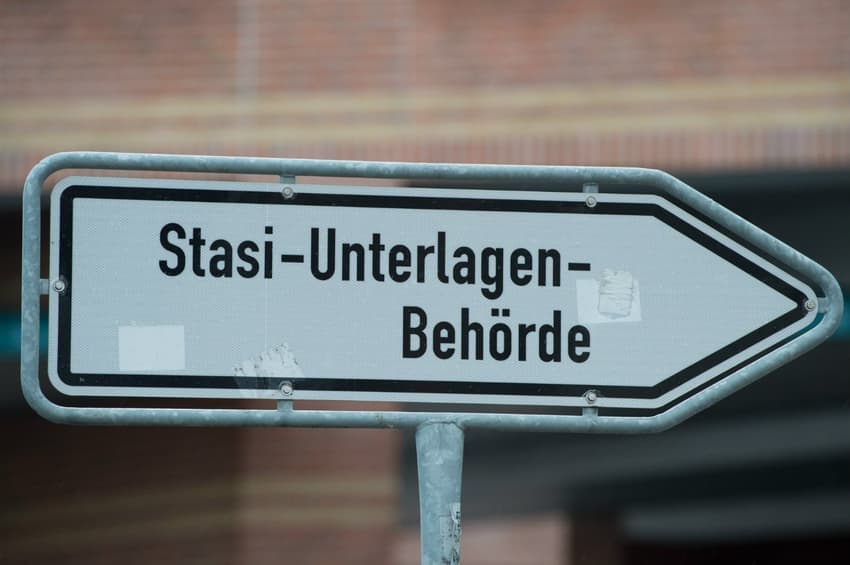Why Germany will never forget the Stasi era of mass surveillance

Exactly 69 years ago, on February 8th, 1950, the fledgling German Democratic Republic(GDR) officially debuted its security service, dedicated to monitoring and preventing outside influences - particularly from the West.
While the many crimes of Nazism still loom large in the popular imagination, we must never forget that for almost 40 years, many East Germans lived in terror of the Ministerium Staatssicherheit - more commonly known as the ‘Stasi’.
With close links to the Russian intelligence services - specifically the KGB - the new organization was provided with training and equipment by the Soviets. This was in order to root out sources of dissent and identify supposed ‘subversive individuals’ who might work against the ‘socialist dream’.
SEE ALSO: Putin's Stasi ID card found in Dresden state archive
The Stasi employed thousands of soldiers, analysts, officials and technical specialists as part of its apparatus across East Germany, and as a consequence nearly every workplace, public venue and educational institute was in some way being watched or listened to.
This practice was carried out via tiny cameras or microphones - in some regards the East Germans were far ahead of their time! This predilection towards surveillance was memorably depicted in the 2006 film ‘Das Leben der Anderen’ (or 'The Lives of Others').
Official trailer to the Sony Pictures film The Lives of Others.
Perhaps even more effective - and terrifying - was the vast network of unofficial informers working for the Stasi, reporting on those who appeared dissatisfied with the government, demonstrated too much a fondness for the West, or somehow stood out.
A system of 'decomposition'
This system of informants was also prone to abuse, with people using the system to denounce their own personal enemies, love rivals and others they didn’t like.
Coupled with this nigh-on omnipotent system of observation and informing was the insidious practice of ‘Zersetzung’, or ‘decomposition’. This was a form of psychological warfare used to at first isolate, then demoralize an individual identified as a troublemaker by the regime.
‘Zersetzung’ could be as simple as having bureaucracy turned against you. In a state like the DDR, the day-to-day life of millions hinged on permits being issued and processes being followed. Purposeful delays, ‘misfilings’ and other interference could seriously frustrate the lives of the state’s political opponents.
A step up might involve fabricated evidence of affairs or other illicit behaviour being circulated, and being sent to the family and friends of someone targeted for ‘Zersetzung’. Reputational damage was the idea during this phase, and there are records of many families being destroyed by these actions.
The final, and perhaps most insidious phase would involve subtle manipulation of objects in the target's home - missing socks, clocks being switched off, furniture rearranged.
Victims still seeking compensation
The objective was to make the target question reality, and it was horrifyingly effective - there are a number of victims of the process actively seeking compensation, despite the GDR having been dissolved for almost 30 years. Strangely enough, former Stasi officers are still receiving pensions.
SEE ALSO: Prisoner turned Stasi spy can fight for pension
SEE ALSO: East Germany - 10 things you never knew about the GDR
The Stasi was a continuous presence in the lives of East Germans right up until 1989, and played a significant role in attempting to vilify those who protesting for greater freedoms and access to the West. Towards the end, it began imprisoning a number of dissidents, and many have written about their experiences in jails such as Berlin-Hohenschönhausen - a grim, miserable place which now offers daily tours in English and German.

A sign on the former Hohenschönhausen prison marking it as a 'Gedenkstätte', or memorial site. Photo: DPA
As the Berlin Wall fell, and the process of reunification was ignited, the Stasi began to start destroying millions of files relating their their surveillance of the East German population. It was only mass-protests, and a storming of the Stasi headquarters on Ruschestraße in Berlin on the January 15th, 1990, that prevented more from being fed to the shredders.
Remnants left behind
Today, the former Stasi headquarters is a museum that not only tells the story of the organization, but also of many of those who were targeted and victimized by the Stasi, with survivors of ‘Zersetzung’ and imprisonment often giving talks.
SEE ALSO: Restored Stasi HQ opens doors to the public
More about the Stasi can be learned at the DDR Museum in Berlin, that makes a point of trying to recreate some of the fear and anxiety caused by the constant surveillance of the regime.
While the survivors of Nazism have almost left us, there are still hundreds of thousands for whom the horrors of the Stasi are all too real, and have a very real effect on their lives. In a world where constant surveillance has become that much easier, we’d do well to remember what that meant for so many, for so long.
EXPLORE:
-
Berlin-Hohenschönhausen Prison Memorial Site Genslerstraße 66, 13055 Berlin
-
Stasi Headquarters Museum Ruschestraße 103, Haus 1, 10365 Berlin
-
DDR Museum/ Karl-Liebknecht-Str. 1, 10178 Berlin
Comments
See Also
While the many crimes of Nazism still loom large in the popular imagination, we must never forget that for almost 40 years, many East Germans lived in terror of the Ministerium Staatssicherheit - more commonly known as the ‘Stasi’.
With close links to the Russian intelligence services - specifically the KGB - the new organization was provided with training and equipment by the Soviets. This was in order to root out sources of dissent and identify supposed ‘subversive individuals’ who might work against the ‘socialist dream’.
SEE ALSO: Putin's Stasi ID card found in Dresden state archive
The Stasi employed thousands of soldiers, analysts, officials and technical specialists as part of its apparatus across East Germany, and as a consequence nearly every workplace, public venue and educational institute was in some way being watched or listened to.
This practice was carried out via tiny cameras or microphones - in some regards the East Germans were far ahead of their time! This predilection towards surveillance was memorably depicted in the 2006 film ‘Das Leben der Anderen’ (or 'The Lives of Others').
Official trailer to the Sony Pictures film The Lives of Others.
Perhaps even more effective - and terrifying - was the vast network of unofficial informers working for the Stasi, reporting on those who appeared dissatisfied with the government, demonstrated too much a fondness for the West, or somehow stood out.
A system of 'decomposition'
This system of informants was also prone to abuse, with people using the system to denounce their own personal enemies, love rivals and others they didn’t like.
Coupled with this nigh-on omnipotent system of observation and informing was the insidious practice of ‘Zersetzung’, or ‘decomposition’. This was a form of psychological warfare used to at first isolate, then demoralize an individual identified as a troublemaker by the regime.
‘Zersetzung’ could be as simple as having bureaucracy turned against you. In a state like the DDR, the day-to-day life of millions hinged on permits being issued and processes being followed. Purposeful delays, ‘misfilings’ and other interference could seriously frustrate the lives of the state’s political opponents.
A step up might involve fabricated evidence of affairs or other illicit behaviour being circulated, and being sent to the family and friends of someone targeted for ‘Zersetzung’. Reputational damage was the idea during this phase, and there are records of many families being destroyed by these actions.
The final, and perhaps most insidious phase would involve subtle manipulation of objects in the target's home - missing socks, clocks being switched off, furniture rearranged.
Victims still seeking compensation
The objective was to make the target question reality, and it was horrifyingly effective - there are a number of victims of the process actively seeking compensation, despite the GDR having been dissolved for almost 30 years. Strangely enough, former Stasi officers are still receiving pensions.
SEE ALSO: Prisoner turned Stasi spy can fight for pension
SEE ALSO: East Germany - 10 things you never knew about the GDR
The Stasi was a continuous presence in the lives of East Germans right up until 1989, and played a significant role in attempting to vilify those who protesting for greater freedoms and access to the West. Towards the end, it began imprisoning a number of dissidents, and many have written about their experiences in jails such as Berlin-Hohenschönhausen - a grim, miserable place which now offers daily tours in English and German.

A sign on the former Hohenschönhausen prison marking it as a 'Gedenkstätte', or memorial site. Photo: DPA
As the Berlin Wall fell, and the process of reunification was ignited, the Stasi began to start destroying millions of files relating their their surveillance of the East German population. It was only mass-protests, and a storming of the Stasi headquarters on Ruschestraße in Berlin on the January 15th, 1990, that prevented more from being fed to the shredders.
Remnants left behind
Today, the former Stasi headquarters is a museum that not only tells the story of the organization, but also of many of those who were targeted and victimized by the Stasi, with survivors of ‘Zersetzung’ and imprisonment often giving talks.
SEE ALSO: Restored Stasi HQ opens doors to the public
More about the Stasi can be learned at the DDR Museum in Berlin, that makes a point of trying to recreate some of the fear and anxiety caused by the constant surveillance of the regime.
While the survivors of Nazism have almost left us, there are still hundreds of thousands for whom the horrors of the Stasi are all too real, and have a very real effect on their lives. In a world where constant surveillance has become that much easier, we’d do well to remember what that meant for so many, for so long.
EXPLORE:
-
Berlin-Hohenschönhausen Prison Memorial Site Genslerstraße 66, 13055 Berlin
-
Stasi Headquarters Museum Ruschestraße 103, Haus 1, 10365 Berlin
-
DDR Museum/ Karl-Liebknecht-Str. 1, 10178 Berlin
Join the conversation in our comments section below. Share your own views and experience and if you have a question or suggestion for our journalists then email us at [email protected].
Please keep comments civil, constructive and on topic – and make sure to read our terms of use before getting involved.
Please log in here to leave a comment.